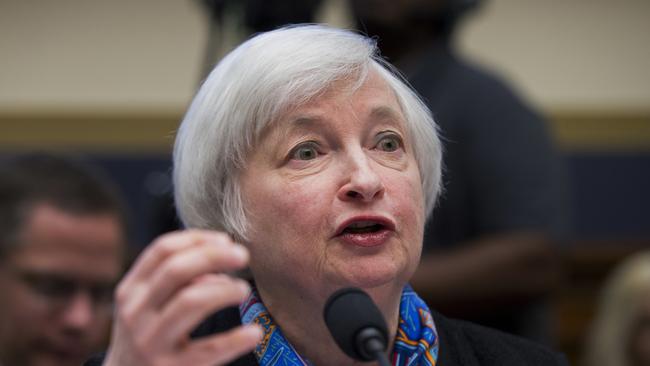Fed officials divided on path of rate hikes
The health of the job market and the outlook for growth caused disagreement at the bank’s June meeting.

Divisions emerged inside the Federal Reserve at its June policy meeting about the economic outlook and how to proceed on interest rate decisions, minutes from the Fed’s June meeting show.
After signalling in April and May they could be ready to lift rates this summer, officials at the June meeting sparred over the health of the labour market, the outlook for growth, risks to the economy and whether underlying inflation is picking up, according to minutes of their June 14-15 meeting. The minutes were released Wednesday with their regular three-week lag.
Amid these divisions, Fed officials agreed that it was “prudent to wait” for additional economic data before deciding on how to proceed, which appears to be the mindset as they head into their July 26-27 meeting.
The Fed raised rates from near zero in December to a range between 0.25 per cent and 0.5 per cent. For much of this year officials have been eyeing another rate increase, based on an expectation that slack in the economy was diminishing and inflation pressures would eventually build. They deferred action because growth and hiring disappointed and new worries emerged.
Investors now see little chance the Fed will raise rates at the July gathering, in the wake of weak employment data released last month by the Labor Department and Britain’s vote to withdraw from the European Union.
Fed officials were preoccupied by the impending vote in the United Kingdom when they gathered last month. The subsequent vote to leave, which sparked market volatility and a strengthening dollar, likely made the Fed all the more cautious about proceeding toward a rate increase.
They emerged from their June gathering with a plan to keep their options open and preserve flexibility to move rates higher if the economy appears to be gathering momentum and safe from new shocks.
“Most participants judged that, in the absence of significant economic or financial shocks, raising the target for the federal funds rate would be appropriate if incoming information confirmed that economic growth had picked up, that job gains were continuing at a pace sufficient to sustain progress toward the committee’s maximum-employment objective and that inflation was likely to rise to 2 per cent over the medium term,” said the minutes.
While there was consensus on this stance, officials disagreed on several issues. Some emphasised that, with labour market conditions and inflation close to the Fed’s objectives, they shouldn’t wait too long to raise rates again. Several also raised concerns that delaying another increase for too long could increase the risks to financial stability or raise the potential for overshooting the committee’s objectives.
However, a couple officials said they wanted to accumulate “sufficient evidence” of a sustained pick-up in inflation and that the economy is strong enough to withstand another rate increase. Several noted the downside risks to the outlook, including the possibility that the weak May employment report and continued weak business investment were a harbinger of a broader slowdown in economic growth.
They also disagreed on the outlook for jobs and growth. While some believed a broad range of indicators, including firmer wage growth, suggested the labour market was near full health, others worried about downside risks to economic growth and weak business investment.
On inflation, several officials worried that bond markets were signalling softening expectations for future inflation, but others pushed back, noting several also suggested that, because rates are still close to zero, the Fed has less room to respond to a rapid increase in inflation than to a weakening in economic conditions.
Since the June meeting, the British vote to leave the E.U. has become an even greater concern at the Fed. Fed Chairwoman Janet Yellen said in a press conference following the June 14-15 meeting that the uncertainty surrounding the Brexit vote was one factor that influenced the Fed’s decision to hold off on a rate increase in June.
“It is a decision that could have consequences for economic and financial conditions in global financial markets,” Dr Yellen said. “If it does so, it could have consequences, in turn, for the US economic outlook that would be a factor in deciding on the appropriate path of policy.”
Fed governor Daniel Tarullo said Wednesday in a Wall Street Journal interview that the global financial system was “reasonably well-prepared” for the vote, and the US response to Brexit has gone how most officials expected. San Francisco Fed President John Williams said Tuesday the effects on the US economy are likely to be “relatively modest,” and said Brexit is less a grave threat than other developments in recent years.
Fed Vice Chairman Stanley Fischer said Friday that officials will have more clarity on the effects of Brexit by the time they meet again on July 26-27. He also said the US economy “has done pretty well” since the weak May jobs report.
Recent data has shown the manufacturing sector has gained a firmer footing, consumer confidence has climbed and household spending is bouncing back after a lacklustre start to the year — though those reports reflect activity before the Brexit vote.
“As we consider the effects of Brexit, we’ve got to put that effect on the US together with what else is going on in the US economy,” Mr Fischer told CNBC. “And probably the other things that are going on are more important for the US outlook … than Brexit all by itself.”
Dow Jones





